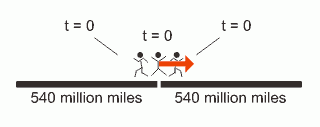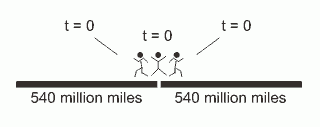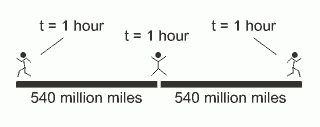-
Posts
1607 -
Joined
-
Last visited
Content Type
Profiles
Forums
Events
Everything posted by Iggy
-
...The result 1,8c is a physical nonsense ...If you want to add 2 velocities, you must use the relativistic formula. Only then the result will have a physical meaning. The physical meaning of velocity is change in distance divided by change in time. If both ships are approaching you at .9c from opposite directions then the distance between the ships in your frame changes at a rate of 1.8c. Do a thought experiment to prove this to yourself. The ships are .9 light-minutes away from you in each direction. The distance between the ships in your frame is 1.8 light-minutes. One minute later the distance between the ships is zero. Change in distance is 1.8 light-minutes and change in time is 1 minute. V=1.8c. The result has the physical meaning it should. Is there any other reason you think this is wrong?
-
No, relativity insists on the following: If u, v, and w are all measured in the same frame then w=u+v is the correct relationship. Rather than just repeating that everyone else is wrong and you are right, maybe you could try to explain why you think you are right or give some text that you think agrees with you.
-
Different frames of reference are different. The relativistic formula isn't used when placing multiple objects with different velocities onto a frame of reference. Many people have corrected you and I've given a source: In the rocket's frame of reference light does not travel c compared to the earth. In earth's frame of reference light does not travel c compared to the rocket. This is earth's reference frame: The distance between the earth and the ray of light changes at a rate of c in this frame (notice the earth is at rest in this frame). The distance between the rocket and the ray of light changes at a rate of w-u in this frame. This is the rocket's reference frame: The distance between the rocket and the ray of light changes at c in this frame (the rocket here is at rest). The distance between the earth and the ray of light changes at w-u in this frame. [edited: I forgot to make u negative in the diagram] Why do you assume this is wrong?
-
Now that you see the frames, Janus' post #32 can't help but make sense.
-
That's because the earth is at rest in the first frame and the rocket is at rest in the second. Both things are moving in the same direction in earth's frame and they are moving in opposite directions in the rocket's frame. Also, the speed of light compared to the earth in the first fame has to be the same as the speed of light compared to the rocket in the second frame. The diagrams are correct. I can't change them.
-
Sorry, I guess I don't follow. I certainly agree that two present events cannot have a causal relationship if they are not co-located, but this would be true regardless of the velocity of the world lines the events populate. I'm sure what you're saying makes sense, I'm just not getting it. No doubt--I agree. I animated some frames that might help. Here is earth's FOR where a rocket (going 0.5c) and a ray of light (the red arrow going 1c) are moving away from the earth in the same direction. This is what the frame looks like at sequential moments in time: And here is the rocket's FOR: V is the velocity (or the change in distance per time) between the rocket and the ray of light. In earth's frame it is .5c and in the rocket's frame it is 1c. In earth's frame the speed of light compared to the rocket is .5c. The rocket 'chases' the light in earth's frame. The astronaut can solve the value of v in earth's frame by finding u and w in earth's frame and solving w=u+v.
-
I'm not confused, Michel. The muon can calculate v in Earth's frame or its own frame. In the muon's frame the muon is at rest and the earth has a velocity of .98c. v is the difference between earth's velocity and light's velocity. In earth's frame v=1c and in the muon's frame v=0.02c. When Janus said, he is saying that you should not switch frames for what you are doing. Light goes .5c faster than the ship in earth's frame just like light goes .02c faster than the earth in the muon's frame. C is the muon. It is 'at rest'. B is the earth. The earth moves to the right at u=.98c compared to the muon. A is a ray of light. The ray of light moves to the right at v compared to the earth and w compared to the muon. If u, v, and w are all in the muon's frame then use u+v=w so that u=0.98c, w=1c and v=0.02c. If u and w are in the muon's frame and v is in earth's frame then use w=(u+v)/(1+uv/c2) so that u=0.98c, w=1c and v=1c. In other words, in earth's frame the distance between the earth and light changes one light-second per second. In the muon's frame, on the other hand, the distance between the earth and light changes .02 light-seconds per second. The value of v depends on which frame you are talking about. In the twin 'paradox' the distance between the ship and a ray of light changes 0.5 light-seconds per second in earth's frame and the distance changes 1 light-second per second in the ship's frame. Does this make sense?
-
How do you mean? (best diagram I could find) A and G are both in the other's past lightcone.
-
yeah, the relativistic equation is probably complicating things needlessly. The distinction can be summed up by saying that light goes 1c faster than the muon in the muon’s frame and that light goes .02c faster than the muon in earth’s frame. In the same fashion, light goes 1c faster than the earth in earth’s frame and light goes .02c faster than the earth in the muon’s frame.
-
v=.02c if it is measured by the same frame of reference that measures u and w. unless u, v, and w are all measured by the same frame of reference you cannot use u+v=w. They are not all measured by the same frame here, so you should not expect to be able to use v=.02c
-
Use u+v=w if u, v and w are all measured by C. Use the relativistic formula if u and w are measured by C and v is measured by B. They are solutions to different problems so you can't substitute the solution of one into the other.
-
It doesn't look like you're going to get it, Owl. The laser and all three people are in the same position at the beginning of the thought experiment. If all three people shoot a laser to the right at the beginning of the thought experiment then, according to your view, all three lasers must be at x = 670 million at the end of the thought experiment. This means that you have an inertial observer (the guy on the left) who shoots a laser and one hour later figures that the laser is 1210 million miles away. Whether you understand or agree or not, this means that he figures the speed of light to be 1210 million mph. In the real world, that doesn't happen. In the real world, the speed of light is the same whether you are drifting to the left or the right. Before a person can understand relativity they have to understand basic mechanics. You have to understand things like velocity and frames of reference. An internet forums is too difficult a setting to explain mechanics from scratch, besides which, you want to debate relativity and assert that you understand it which makes learning it all the more difficult. All told, I don't see any point in trying to communicate further. I realize that you don't see any problem with what you are saying. You don't see how your view conflicts with relativity. I think Dr. Rocket summed everything up nicely saying that the real problem is that you don't understand that you don't understand. I'm sure now that I won't be able to change that.
-
That's right. If one thing in my frame is going c and something else in my frame is going .98c then the difference in the speeds according to my frame is c-.98c. I'm not sure what you mean by that. Yes, because we are not switching frames you don't have to use the relativistic formula. The relativistic addition formula is when you ask "A is going u in my FOR and B is going v in the FOR of A -- how fast is B going in my frame?" We are saying "A is going u in my frame and B is going v in my frame -- how much faster is B going than A in my frame?". For this question you don't need the relativistic addition formula. In case I explain badly, here is a website explaining the difference: http://www.phys.ncku.edu.tw/mirrors/physicsfaq/Relativity/SR/velocity.html
-
As I understand them, they are exactly correct. A good example, because it is observable, is the frame of a muon which is created by cosmic rays in the upper atmosphere and moves toward the earth's surface at 98% the speed of light. In our earth frame light moving from the upper atmosphere to the lower atmosphere moves at 1c and muons moving from the upper to lower atmosphere move at .98c. They are chasing light, as you put it, in our frame. In the muon's frame, the muon itself is at rest. Light moves from the surface of the earth towards it at 1c and the earth moves towards it at .98c. So, I agree, the earth is chasing its own light in the muon's frame.
-
I didn't specify who shot the laser because it doesn't matter. The guy on the left did not travel 540 million miles away from himself. We are saying that light must recede at 670 million mph from any inertial observer which includes all three people in this thought experiment. That is what a constant speed of light means. The speed of light, as figured by the guy on the left, is 1210 million miles per hour in this thought experiment. They can all three shoot a laser at the beginning, it doesn't matter. You have said that the speed of light is independent of the speed of the source, so the rays need to stay together. The guy on the left is no different from any guy that's floating in space. In this Newtonian thought experiment, he shoots a laser and one hour later the laser light is 1210 million miles away. This means that the laser receded from him at 1210 million mph. But, that is not how the world works. The speed of light is constant/invariant which means that any person who is moving at a constant velocity can look at a ray of light that is moving away from them and say "that light is moving 670 million miles every hour away from me". This thought experiment is different from the real world. The guy on the left cannot look at the ray of light and say "that light is moving 670 million miles every hour away from me". If distance and time are constant (meaning, everyone agrees on them) then the speed of light is not constant. I agree on both points.
-
I disagree. As I have said in earlier post, Michelson-Morley experiment failed to find the ether that was believed to be the medium for conducting EM radiation. But it said nothing one way or the other about Einstein's light postulate: the speed of light being constant in all inertial frames. It was an indication. Michelson and Morley expected to get different results at different times of day and different times of year because the equipment changed reference frame as earth rotates and orbits the sun. Because the equipment did not give different results in different reference frames, it indicated that an invariant speed of light was a possibility. If you are floating in space and you shoot a laser and 1 hour later it is 1210 million miles away then the laser light is receding from you at a velocity of 1210 million mph. Do you mean at the speed of light or under the speed of light?
-
No trouble mate. I agree. While I think it would cloud my point, I don't think there would be any conceptual problem extending the thought experiment that far. The light will have traveled 670 miles to go to the mirror 670 miles to come back at origin. 540 miles to go left Total 1880 miles in time: 1 hour to go 1 hour to come back at origin 0,8 hour to go left (approx 540/670=0,8059) Result 1880 miles/2,8 hours = 670 miles/hour If the guy on the left were stationary relative to the guy in the center then I would agree. When the light reaches 540 million miles left of origin the guy on the left wouldn't be in that spot any more. The easiest thing to do is to describe the extended thought experiment from the center person's frame then do Galilean transforms to move to the other frames. Assuming the mirror is stationary in the center person's frame, it would end up being that the light is detected by the guy on the left 10.3 hours after it is emitted (in both frames). The light would travel a total of 6.90615 x 10^9 miles in the center frame and 2.420 x 10^9 miles in left frame. Like I said earlier I wouldn't have a problem telling you otherwise if I thought otherwise.
-
I think so too, and I think "the stuff measured by rods" would be a good definition of space. The link I just quoted from is the 1926 Encyclopædia Britannica entry on space-time written by Einstein. From what I just read, it looks like a good treatment of the subject.
-
Good. At t=0 the distance between the light and all three people is zero At t = 1 hour the distances are The distance between the left guy and the light changes 1210 million miles in one hour. He finds the speed of light to be 1210 million miles per hour. The distance between the center guy and the light changes 670 million miles in one hour. He finds the speed of light to be 670 million miles per hour. The distance between the right guy and the light changes 130 million miles in one hour. He finds the speed of light to be 130 million miles per hour. By assuming that distance, time, and simultaneity are constant (in other words, those things are the same for all observers) we have found that the speed of light is not constant (it is not the same for all observers). Since you have said that you believe the speed of light is constant you should see that you are contradicting yourself. The speed of light actually is constant in all inertial reference frames. The first good indication of this was with the Michelson–Morley experiment in 1887. They assumed the world worked the way you described it and the way I drew it in the diagram. If the speed of light is c for one person then it would be c-v for another person who is moving with a speed v in the direction of the light. In other words, if Leonardo (the guy in the middle of the diagram) figures that light is moving to the right at 670 million mph and there is another guy floating to Leonardo's right at 540 million mph then the guy on the right would figure that the distance between the light and himself changes 130 million miles in one hour. That is what the diagram shows and it is intuitive. What they found instead is that light moves at c for anyone in any inertial reference frame. It is invariant and constant. The guy on the right finds that the distance between the light and himself changes 670 million miles in one hour. Albert Einstein explained the constant speed of light by making distance and time variable in special relativity. The invariant speed of light and the predictions of relativity are confirmed accurately and regularly with things like GPS. In other words, you say that everyone in the diagram will agree that the distance between the guy on the left and the laser beam changes 1210 million miles in one hour. If fact, the guy on the left should find that the distance changes 670 million miles in one hour.
-
Understood. Good. Thank you. Only two more questions then. If they shoot a laser to the right at the onset, then after an hour everything is positioned like this? Do each of our thought experiment cosmonauts agree that this is the position of everything?
-
That was not the question. I am not asking what possible beliefs the stick figures might have. I am showing that your beliefs are inconsistent. To do this you must assume that all of the people in the thought experiment are using your system of mechanics (absolute space, time, and present). If I ask "do they all agree on the location" you cannot answer "No, I don't think everyone will agree, because some of you believe in length contraction". That is a non-answer. Saying "I don't know what other people believe" is not an answer to "If everyone in the thought experiment thinks like you do and believes like you believe then they all agree on the position of everyone at the end of the hour, yes?". It is not an answer to that question. There is a reason why this question is specifically important. If you cannot answer it then we cannot continue. If everyone in the thought experiment thinks like you do and believes like you believe then they all agree on the position of everything at the end of the hour, yes?
-
I can affirm that. Michel, by the end of the thought experiment I will have decomposed the frames. I still need to add another element first. Hopefully a quick "yes" from Owl will let me go ahead with that.
-
I'm using crayons, Tipp-Ex, and stick figures to show that absolute time, length, and simultaneity are inconsistent with a constant speed of light.
-
Good. Thank you. I should have been more specific. If everyone in the thought experiment thinks like you do and believes like you believe then they all agree on the position of everyone at the end of the hour, yes? Let me do a graphic: At t = 0 everyone agrees this is everyone's position as well as the position of the rods, yes? At t = 1 hour everyone agrees that this is everyone and everything's position, yes? Is that correct?
-
Only if you use the Euclidean metric. Google Minkowski space. In a Euclidean metric that is true. Where the metric is s^2 = t^2-x^2 it is not.






